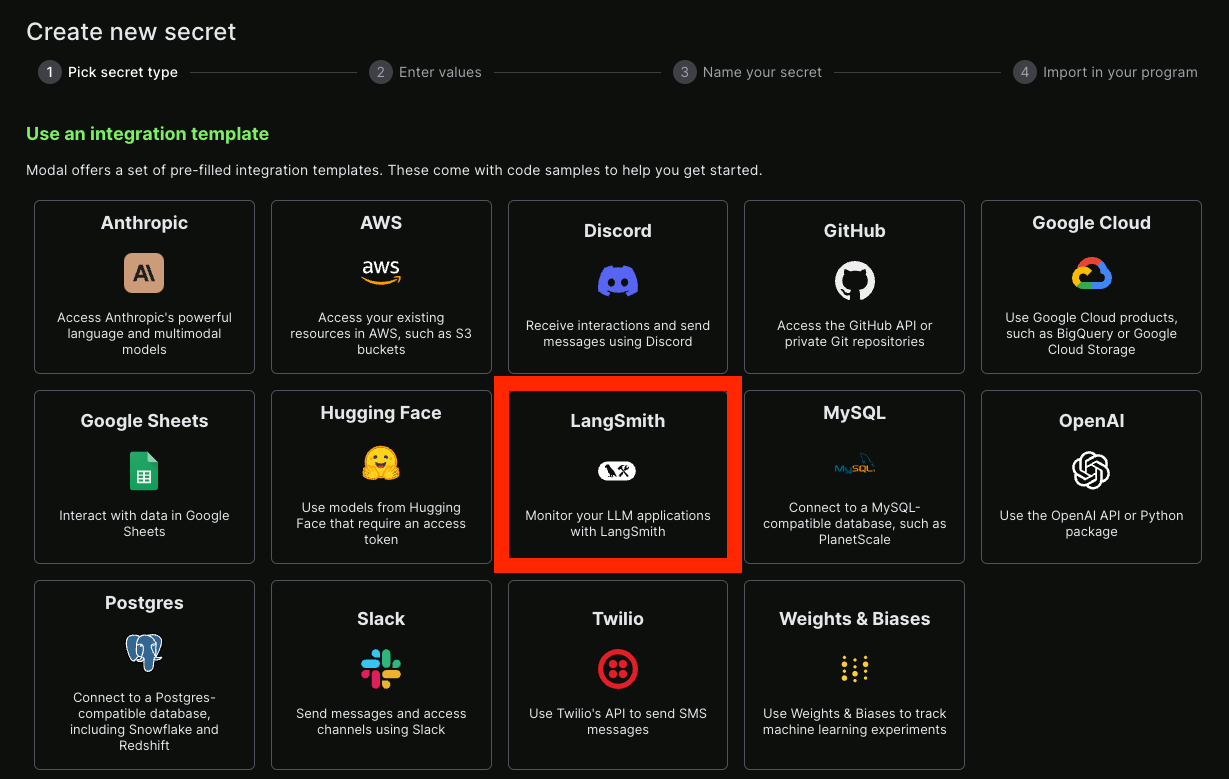How to use webhooks with automations
When you add a webhook URL on an automation action, we will make a POST request to your webhook endpoint any time the rules you defined match any new runs.
Webhook Payload
The payload we send to your webhook endpoint contains
- "rule_id" this is the ID of the automation that sent this payload
- "start_time" and "end_time" these are the time boundaries where we found matching runs
- "runs" this is an array of runs, where each run is a dictionary. If you need more information about each run we suggest using our SDK in your endpoint to fetch it from our API.
This is an example webhook payload
{
"rule_id": "d75d7417-0c57-4655-88fe-1db3cda3a47a",
"start_time": "2024-04-05T01:28:54.734491+00:00",
"end_time": "2024-04-05T01:28:56.492563+00:00",
"runs": [
{
"status": "success",
"is_root": true,
"trace_id": "6ab80f10-d79c-4fa2-b441-922ed6feb630",
"dotted_order": "20230505T051324571809Z6ab80f10-d79c-4fa2-b441-922ed6feb630",
"run_type": "tool",
"modified_at": "2024-04-05T01:28:54.145062",
"tenant_id": "2ebda79f-2946-4491-a9ad-d642f49e0815",
"end_time": "2024-04-05T01:28:54.085649",
"name": "Search",
"start_time": "2024-04-05T01:28:54.085646",
"id": "6ab80f10-d79c-4fa2-b441-922ed6feb630",
"session_id": "6a3be6a2-9a8c-4fc8-b4c6-a8983b286cc5",
"parent_run_ids": [],
"child_run_ids": null,
"direct_child_run_ids": null,
"total_tokens": 0,
"completion_tokens": 0,
"prompt_tokens": 0,
"total_cost": null,
"completion_cost": null,
"prompt_cost": null,
"first_token_time": null,
"app_path": "/o/2ebda79f-2946-4491-a9ad-d642f49e0815/projects/p/6a3be6a2-9a8c-4fc8-b4c6-a8983b286cc5/r/6ab80f10-d79c-4fa2-b441-922ed6feb630?trace_id=6ab80f10-d79c-4fa2-b441-922ed6feb630&start_time=2023-05-05T05:13:24.571809",
"in_dataset": false,
"last_queued_at": null,
"inputs": null,
"inputs_s3_urls": null,
"outputs": null,
"outputs_s3_urls": null,
"extra": null,
"events": null,
"feedback_stats": null,
"serialized": null,
"share_token": null
}
]
}
Webhook Security
We strongly recommend you add a secret query string parameter to the webhook URL, and verify it on any incoming request. This ensures that if someone discovers your webhook URL you can distinguish those calls from authentic webhookn notifications.
An example would be
https://api.example.com/langsmith_webhook?secret=38ee77617c3a489ab6e871fbeb2ec87d
Webhook Delivery
When delivering events to your webhook endpoint we follow these guidelines
- If we fail to connect to your endpoint, we retry the transport connection up to 2 times, before declaring the delivery failed.
- If your endpoint takes longer than 5 seconds to reply we declare the delivery failed and do not .
- If your endpoint returns a 5xx status code in less than 5 seconds we retry up to 2 times with exponential backoff.
- If your endpoint returns a 4xx status code, we declare the delivery failed and do not retry.
- If your endpoint returns any body do not read it
Example with Modal
Setup
For an example of how to set this up, we will use Modal.
First, create a Modal account. Then, locally install the Modal SDK:
pip install modal
Secrets
Next, you will need to set up some secrets.
First, we will set up a secret to use to authenticate to our server.
You can see instructions for secrets here.
For this purpose, let's call our secret ls-webhook and have it set an environment variable with the name LS_WEBHOOK.
We can also set up a LangSmith secret - luckily there is already an integration template for this!

Service
After that, you can create a Python file that will serve as your endpoint. An example is below, with comments explaining what is going on:
from fastapi import Depends, HTTPException, status, Request, Query
from fastapi.security import HTTPBearer, HTTPAuthorizationCredentials
from modal import Secret, Stub, web_endpoint, Image
from langsmith import Client
# Create a job called "auth-example" that install the `langsmith` package as a dependency
# Installing `langsmith` is just an example, you may need to install other packages
# depending on your logic.
stub = Stub("auth-example", image=Image.debian_slim().pip_install("langsmith"))
# These are the secrets we defined above
@stub.function(
secrets=[
Secret.from_name("ls-webhook"),
Secret.from_name("my-langsmith-secret")
]
)
# We want this to be a `POST` endpoint since we will post data here
@web_endpoint(method="POST")
# We set up a `secret` query parameter
async def f(request: Request, secret: str = Query(...), ):
# First, we validate the secret key we pass
import os
if secret != os.environ["LS_WEBHOOK"]:
raise HTTPException(
status_code=status.HTTP_401_UNAUTHORIZED,
detail="Incorrect bearer token",
headers={"WWW-Authenticate": "Bearer"},
)
# Now we load the JSON payload for the runs that are passed to the webhook
body = await request.json()
# This is where we put the logic for what should happen inside this webhook
runs = body['runs']
ls_client = Client()
ids = [r['id'] for r in runs]
feedback = list(ls_client.list_feedback(run_ids=ids))
for r, f in zip(runs, feedback):
try:
ls_client.create_example(
inputs=r['inputs'],
outputs={'output': f.correction},
dataset_name="classifier-github-issues"
)
except Exception as e:
raise ValueError(f"{r} and {f}")
# Function body
return "success!"
We can now deploy this easily with modal deploy ... (see docs here).
You should now get something like:
✓ Created objects.
├── 🔨 Created mount /Users/harrisonchase/workplace/langsmith-docs/example-webhook.py
├── 🔨 Created mount PythonPackage:langsmith
└── 🔨 Created f => https://hwchase17--auth-example-f.modal.run
✓ App deployed! 🎉
View Deployment: https://modal.com/apps/hwchase17/auth-example
The important thing to remember is https://hwchase17--auth-example-f.modal.run - the function we created to run.
NOTE: this is NOT the final deployment URL, make sure not to accidentally use that.
Hooking it up
We can now take the function URL we create above and add it as a webhook. We have to remember to also pass in the secret key as a query parameter. Putting it all together, it should look something like:
https://hwchase17--auth-example-f-dev.modal.run?secret={SECRET}
Replace {SECRET} with the secret key you created to access the Modal service.